The Plextor M6V (256GB) SSD Review
by Billy Tallis on October 12, 2015 8:00 AM ESTRandom Read Performance
Our random read performance test is conducted on a full drive and tests queue depths from 1 to 32. We focus primarily on the lower queue depths that are typical of interactive use, but also look at how the performance and power scales to more intensive loads. For desktop use, searching and virus scanning are typically the biggest sources of random reads, and they can exercise some of the larger queue depths.
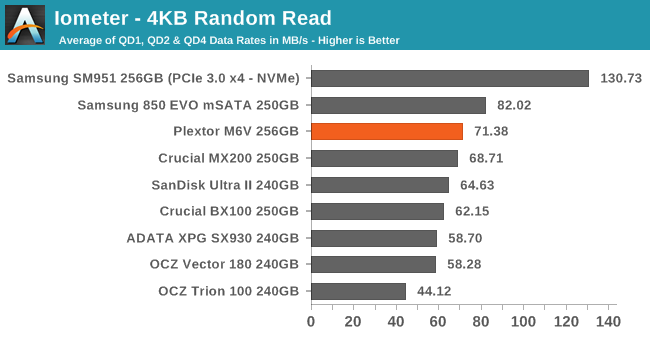
The M6V posts above average performance on the random read test, and is clearly better tuned for it than the Crucial BX100.
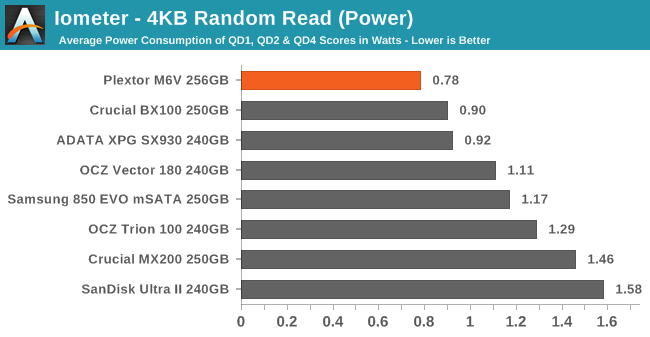
The power consumption and thus efficiency here are significantly better than the competition.
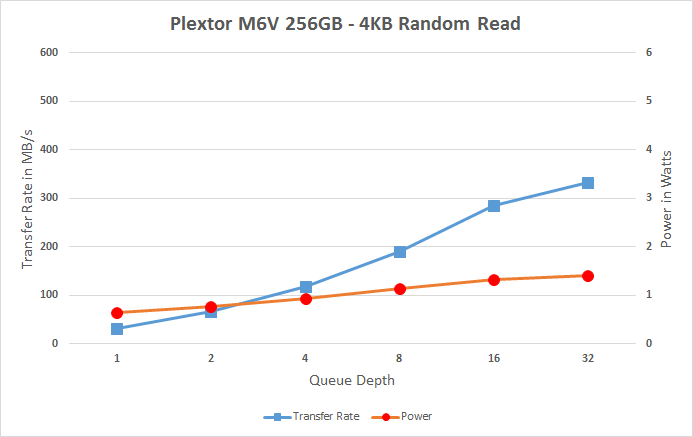 |
|||||||||
| Default | |||||||||
The M6V scales well with increasing queue depths, and its high rating above comes mostly from its good performance with queue depths of 2 and 4. Power consumption starts low and only grows slightly.
Random Write Performance
The random write test is confined to a 16GB portion of the drive, which is otherwise empty. This allows the drive to demonstrate much higher performance than on our performance consistency test that fills the drive. Tasks like installing software updates can modify a lot of files, but aren't hitting the entire disk. Random writes to the entire disk are usually found only in enterprise workloads such as large databases.
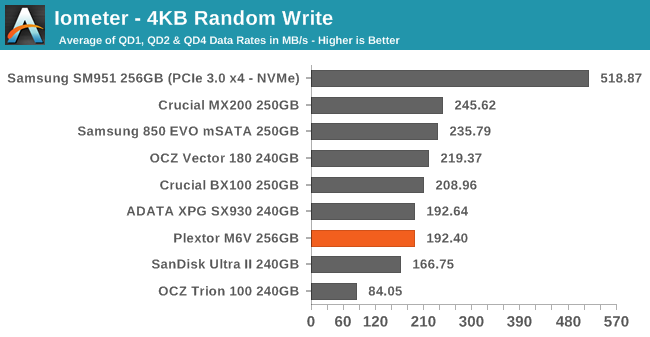
The M6V falls back to being one of the slowest MLC drives, but the spread among 240-256GB drives isn't huge.
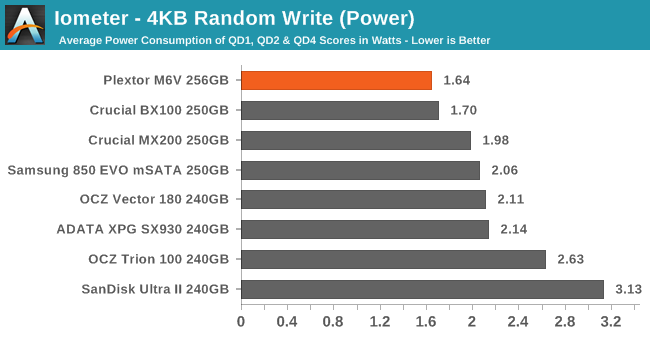
The lower performance again brings power savings, showing that the M6V is pretty well optimized, just not for peak performance.
 |
|||||||||
| Default | |||||||||
Many drives of this size hit a performance limit somewhere along this test, but the M6V scales smoothly across the range of queue depths. However, the overall increase is small and the lower queue depths are left lacking.










51 Comments
View All Comments
mczak - Monday, October 12, 2015 - link
I beg to differ. For 90% of all use cases, the performance difference of a pcie drive to a sata one will be minimal if not unnoticeable whereas the pcie one is a lot more expensive (for now - I don't see a technical reason for this, really). Whereas everybody probably agrees the performance difference from sata ssd to sata HD is definitely noticeable.Albeit this drive indeed doesn't really offer anything interesting. There's nothing wrong with that but that means it has to nearly exclusively compete based on price, which it currently does not.
svan1971 - Monday, October 12, 2015 - link
simply not true, having used an sm951 for 3 months now the performance increase over the 850 is absolutely noticeable from bootup to shutdown and everything in between.geniekid - Monday, October 12, 2015 - link
http://techreport.com/review/28446/samsung-sm951-p...According to techreport boot times are noticeably faster and general loading times are not.
JimmiG - Tuesday, October 13, 2015 - link
We're still just talking about a few seconds difference. Most people won't notice the difference between a boot time of 37 seconds and 33 seconds. What people will notice is the difference between *any* SSD and any regular HDD.Most consumers should just get the cheapest SSD at the highest capacity they can afford. The performance difference isn't enough to justify going with e.g. a higher-performance 250GB SSD over a slightly slower 500GB drive (which allows you to store more of your data on the SSD instead of your much slower HDD).
mapesdhs - Wednesday, October 14, 2015 - link
Irony is, right now the 850 EVO is also one of the best value SSDs available. Atm I wouldn't choose anything else for mainstream use.emn13 - Tuesday, October 13, 2015 - link
Even if this were true (which really depends on your workload - for common workloads it really isn't), that doesn't mean it'd be a good idea to pick between the extremely expensive PCIe solutions and the extremely slow HDD solutions - old fashioned SATA still commands the sweet spot.Perhaps not for much longer, of course :-).
Clauzii - Monday, October 12, 2015 - link
Also, try hotswapping a PCIe-card :)Billy Tallis - Monday, October 12, 2015 - link
M.2 doesn't support hotplug, but it's been part of PCIe forever and is supported by both the normal full size expansion card form factor and the U.2 connector. The problem is that consumer-class systems often don't bother to fully implement support for the feature, though obviously they support it on some level for the sake of ExpressCard and Thunderbolt.Ramalth - Wednesday, October 14, 2015 - link
Not taking in consideration that you cannot add or replace (most) laptops HDD with PCI-Express versions, so you have to use a SATA drive forcefully ...devione - Monday, October 12, 2015 - link
What's the point of having bicycles when there are cars?What's the point of having cars when there are airplanes?